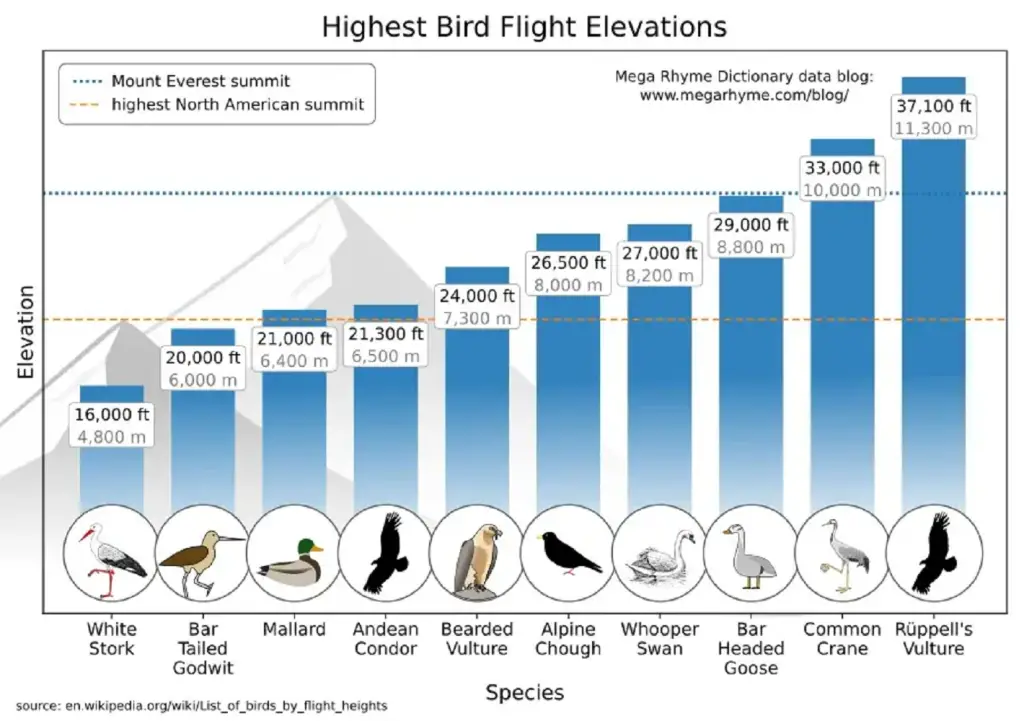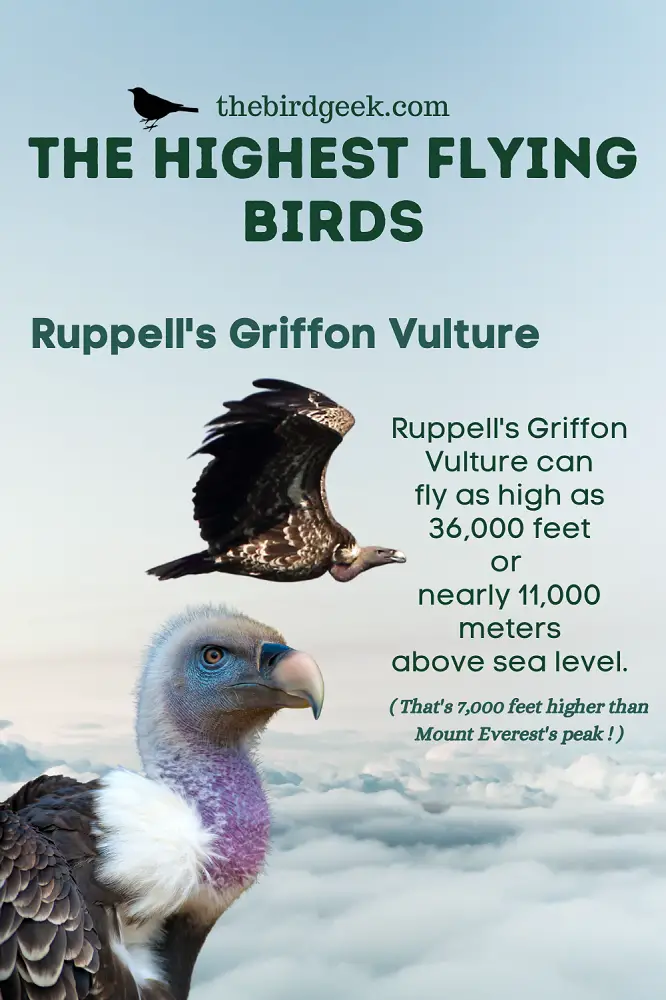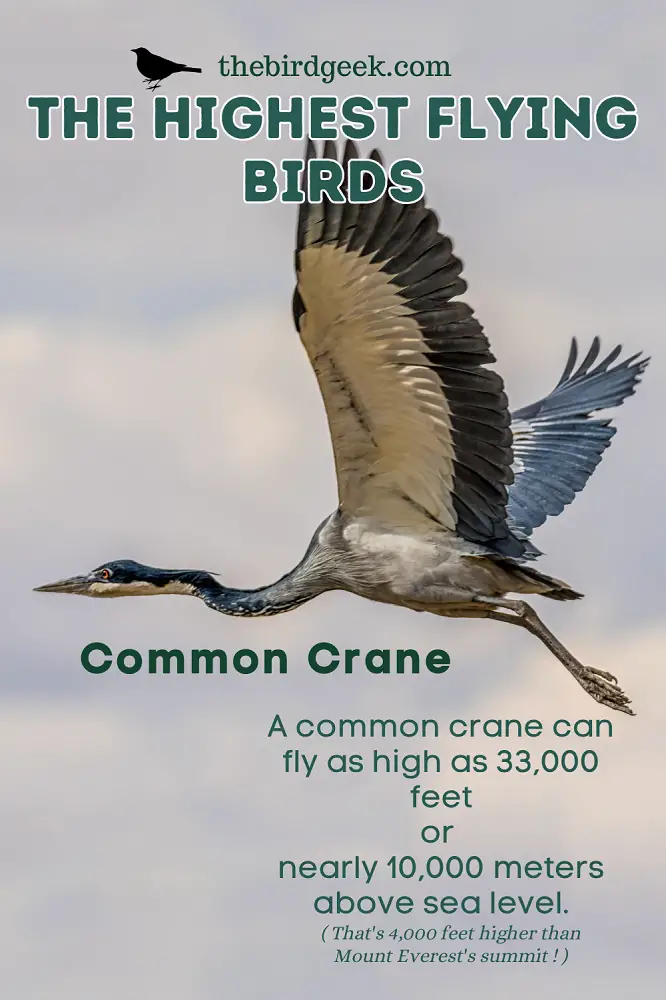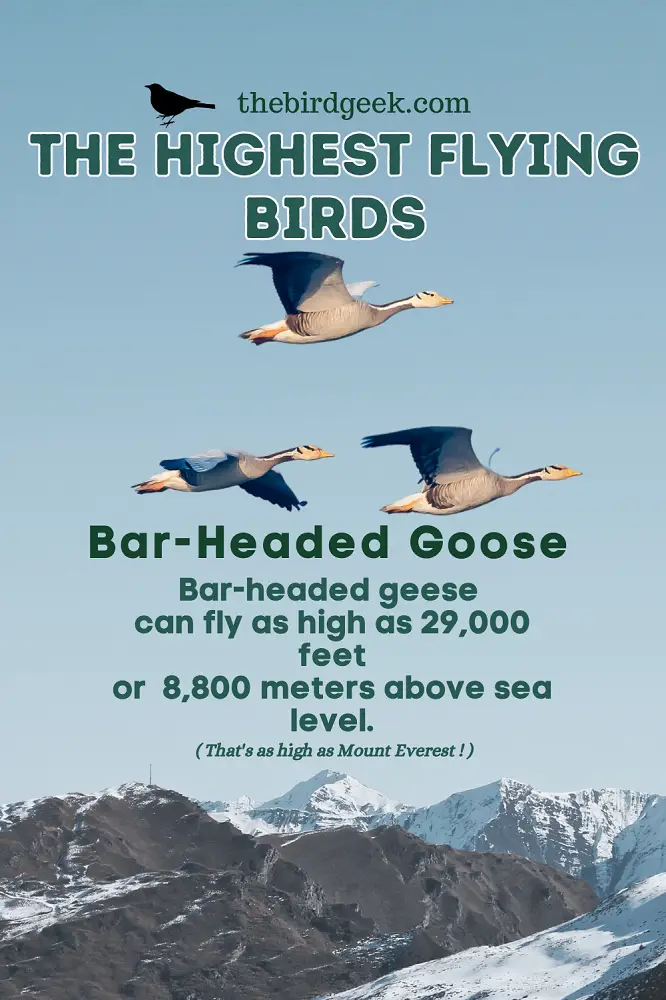The Highest Flying Birds
Have you ever just sat and watched birds flying fearlessly 200 or 300 feet above your head and wondered how they could do it? If so, you’re not alone: ancient man not only watched high-flying birds with awe but venerated those that flew the highest, as they were closest to the spirits or “gods” of ancient times. However, 200 or 300 feet is nothing for some birds.
There are many species that not only fly over 10,000 and 20,000 feet (3,048 and 6,096 meters) but which fly high enough to get hit by airplanes. But just what are the highest-flying birds, and where can you find them? Let’s take a deep dive into this interesting subject to examine these fascinating species and the many worlds that they inhabit.

1. Ruppell’s Griffon Vulture: 36,000 Feet or Nearly 11,000 Meters Above Sea Level

These large African vultures are known for their expansive eight-foot wingspan and were once common throughout the Sahel region of Africa. Tragically, they’re critically endangered, with only 22,000 known individuals left. Their incredible ability to fly high is due to a protein alteration that lets them fly very high with minimal oxygen and low air pressure.
Unfortunately, the Ruppell’s griffon vulture’s amazingly high flying height was discovered not through careful scientific study but through an upsetting accident. During a flight above Cote d’Ivoire, an airplane’s engine sucked in a Griffon vulture and killed it at 36,100 feet. Since then, scientists have warned pilots to watch out for the Ruppell’s griffon vulture as they fly.
2. Common Crane: 33,000 Feet or 10,000 Meters

The common crane might not sound like an incredibly interesting bird at first glance. Though it’s quite beautiful and able to easily migrate between Eurasia and Africa, its most interesting trait is its high flying height: the common crane has been spotted flying at 33,000 feet or 10,000 meters above sea level. This incredible feat was spotted in the Himalayan mountains.
Scientists believe the common crane evolved this amazing ability to avoid eagles, which commonly patrol mountains looking for prey like the crane. By flying far higher than eagles can feasibly soar, the common crane avoids their most persistent predator and can hunt in peace. It’s this kind of wonderful evolutionary trait that makes science so fascinating.
3. Bar-Headed Goose: 29,000 Feet or 8,800 Meters

Like the common crane, the bar-headed goose is a migratory bird commonly spotted in Asia but has been spotted in many other parts of the world after escaping zoos. They’re known for their black-and-white head with yellow bills and legs. They’ve also been spotted flying as high as 29,000 feet by scientists, which is one of the highest migratory paths yet discovered.
Tracking a goose with a GPS implant, scientists discovered that it utilized an up-and-down flight path similar to a rollercoaster. At first, confused by this pattern, researchers discovered that it helped minimize the bird’s strain as it flew. Incredibly, they don’t soar by other birds or use tailwinds: instead, they flap their wings constantly while migrating!
4. Whooper Swan: 27,000 Feet or 8,200 Meters

The whooper or common swan is the Eurasian cousin of the North American trumpeter swan and is known for its natural elegance, beautiful plumage, and incredible flying heights. The discovery of their amazingly high flight wasn’t exactly scientific: a pilot flying between Iceland and Europe spotted one flying at 27,000 feet and noted it in their flight book.
Most scientists accept this discovery because of the pilot’s knowledge and interest in birds and the whooper swan’s preferred natural habits. Whooper swans regularly nest in areas 700 meters or nearly 2,300 feet above sea level and has been seen many times crossing oceans at 1,700 meters or 5,577 feet. It’s therefore conceivable that they could fly very high regularly.
Related post: The Largest Birds on the Planet!
5. Alpine Chough: 26,500 Feet or 8,000 Meters

The Alpine chough is not a bird you’ll likely see often due to their preference for high-flying and breeding areas. Though fairly widespread throughout South Europe, North Africa, and Central Asia, they’ve adapted to the thin atmosphere of high elevations. They can breathe easily in these areas while other birds cannot.
They’re known to breed between 1,260 to 2,800 meters (4,130 to 9,450 feet) and have been spotted flying as high as 26,900 feet (6,500 meters) over Mount Everest. It prefers nesting in cavities and fissures on tough rock faces and is most commonly spotted near hotels and ski resorts high in mountainous areas. You won’t see the Alpine chough in the wild unless you want to travel to these spots.
Related post: The Fastest Flying Birds In The World!
6. Bearded Vulture: 24,000 Feet or 7,400 Meters

In the annals of strange deaths, Greek playwright Aeschylus may have the weirdest: in 455 BC, he is said to have been killed by a tortoise dropped from a great height onto his bald head. Though later written off as a comic story told in bad taste by a Greek wit, this legend has expanded in recent years to the point that questionably researched articles blame the poor bearded vulture for this event.
Well, turns out this vulture does, in fact, open turtle shells and will fly at incredible heights. Once referred to as the “devil bird” by European hunters, the bearded vulture has been spotted for many years high above the ground. Tragically, its record-breaking flight was noted when it was hit by a plane at 24,000 feet above sea level.
Related post: Famous Birds in Literature
7. Andean Condor: 21,300 Feet or 6,500 Meters

The largest bird of prey in the world, the Andean condor is also one of the highest-flying birds in the world. They’ve been regularly spotted flying 16,000 feet (4,876 meters) above sea level and have been spotted even higher. Andean condors can also fly long distances and are known to soar over regions looking for dead animals: they are carrion-eaters that help keep areas clean.
That said, the Andean condor can and will hunt if necessary and is known to spend four days looking for appropriate food. Their bodies are not naturally built for hunting, which makes carrion a much better dining option. Amazingly, they can live for nearly 100 years (75 is the current record), making them one of the longest-lived birds in the world!
Related post: Famous Bird Gods
Wrap Up – The Highest Flying Birds
We definitely enjoyed making this list of the highest flying birds documented! My mind’s blown about those common cranes flying higher than the Everest!
These birds can be great representations for reaching dreams and going above and beyond! Which of them surprised you that they made it on this list? Let us know in the comments!
Related post: The Coolest Birds!
References: